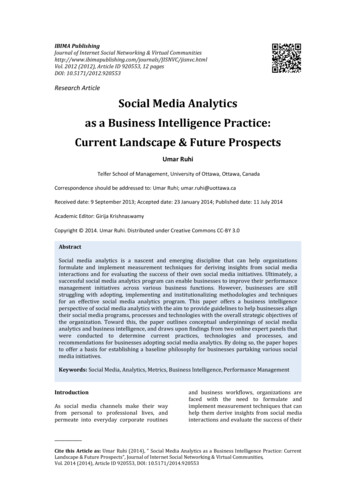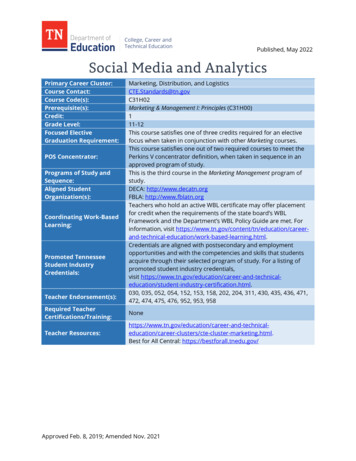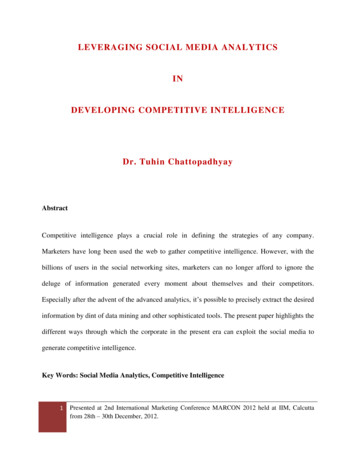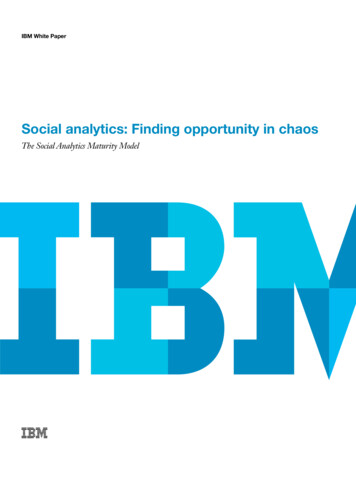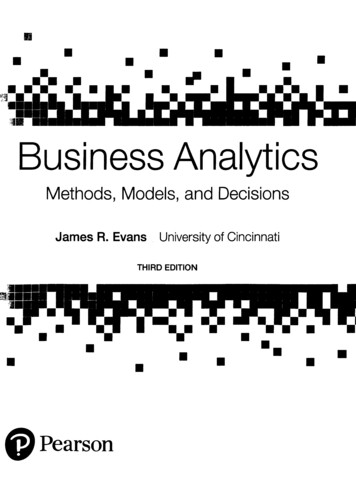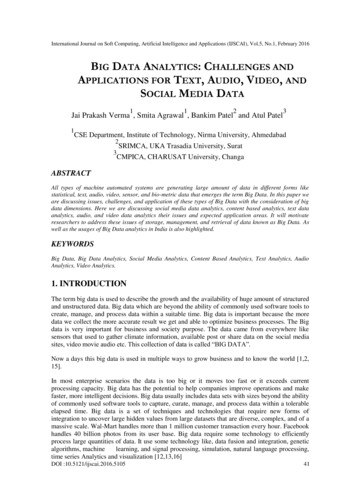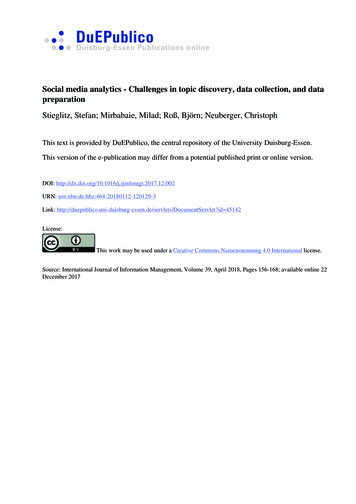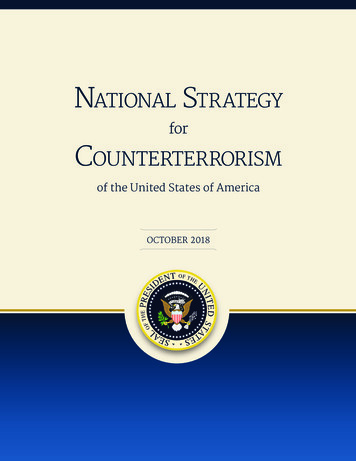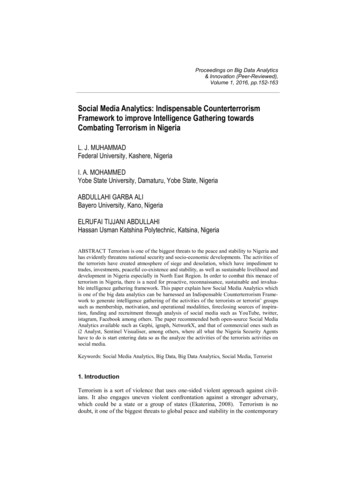
Transcription
Proceedings on Big Data Analytics& Innovation (Peer-Reviewed),Volume 1, 2016, pp.152-163Social Media Analytics: Indispensable CounterterrorismFramework to improve Intelligence Gathering towardsCombating Terrorism in NigeriaL. J. MUHAMMADFederal University, Kashere, NigeriaI. A. MOHAMMEDYobe State University, Damaturu, Yobe State, NigeriaABDULLAHI GARBA ALIBayero University, Kano, NigeriaELRUFAI TIJJANI ABDULLAHIHassan Usman Katshina Polytechnic, Katsina, NigeriaABSTRACT Terrorism is one of the biggest threats to the peace and stability to Nigeria andhas evidently threatens national security and socio-economic developments. The activities ofthe terrorists have created atmosphere of siege and desolation, which have impediment totrades, investments, peaceful co-existence and stability, as well as sustainable livelihood anddevelopment in Nigeria especially in North East Region. In order to combat this menace ofterrorism in Nigeria, there is a need for proactive, reconnaissance, sustainable and invaluable intelligence gathering framework. This paper explain how Social Media Analytics whichis one of the big data analytics can be harnessed an Indispensable Counterterrorism Framework to generate intelligence gathering of the activities of the terrorists or terrorist’ groupssuch as membership, motivation, and operational modalities, foreclosing sources of inspiration, funding and recruitment through analysis of social media such as YouTube, twitter,istagram, Facebook among others. The paper recommended both open-source Social MediaAnalytics available such as Gephi, igraph, NetworkX, and that of commercial ones such asi2 Analyst, Sentinel Visualiser, among others, where all what the Nigeria Security Agentshave to do is start entering data so as the analyze the activities of the terrorists activities onsocial media.Keywords: Social Media Analytics, Big Data, Big Data Analytics, Social Media, Terrorist1. IntroductionTerrorism is a sort of violence that uses one-sided violent approach against civilians. It also engages uneven violent confrontation against a stronger adversary,which could be a state or a group of states (Ekaterina, 2008). Terrorism is nodoubt, it one of the biggest threats to global peace and stability in the contemporary
PBDAI(P-R)times. Since the beginning of this millennium, the incidences of the terrorism havebeen on a steady rise worldwide. In Africa, indeed the manifestation of terrorismhas been evident in some countries like Cameroon, Somalia, Mali, and Nigeria. InNigeria, the phenomenon has found expression in the emergence of Boko Haraminsurgency in 2009. The Boko Haram appears to be the most visible security threatto the country and launched violent attacks on the Nigerian State, killing thousandsof people and destroying public and private properties in different parts of thecountry (United States Embassy, Nigeria, 2014). Globally, the group is now labeled as one of the most deadly insurgent/terrorist groups in the world. Like mostof the terrorist groups, it seems to defy several counter terrorism measures introduced by the Nigerian government (Ayuba, 2013).Social media are computer-mediated tools or online platforms that allow individuals, companies and organizations to create, share, or exchange information,career interests, ideas, and pictures/videos in virtual communities and networks.(Buettner, 2016). The Social Media which have no doubt flooded every facet ofhuman endeavor and are also being taken advantages by terrorists to propagatetheir extreme ideologides, recruit new members, train their members, communicateand conspire with international linkages, and raise funds among others. Arisingfrom this background, this paper recommends that, the Social Media Analytics asan Indispensable Counterterrorism Framework to improve Intelligence Gatheringtowards Combating Terrorism in Nigeria through analysis of the Social Media platforms such as facebook, twitter. youtube among others so as to uncover the activities of Boko Haram such as membership, motivation, and operational modalities,foreclosing sources of inspiration, funding and recruitment.1.1 Social media and TerrorismSocial media are web or mobile based interactive platforms through which individuals, communities and organizations to create, share, or exchange information,career interests, ideas, and pictures/videos. Social Media consists of websites suchas YouTube (video-sharing), Twitter and Tumblr (micro-blogging), Facebook(social networking), StackOverflow (community based question and answering),Delicious (social bookmarking), online wikis, message boards and discussion forums. Social media platforms are highly participatory and collaborative in nature inwhich users can easily share content and post messages and comments (Kietzmannet al.,2011). Because of its cheap affordability, convenience and easy broad-reachof social media platforms, terrorists groups have increasingly use them to propagate their ideologies, spread their messages, recruit members, raise funds and gather intelligence. Today, almost 90 percent of terrorists’ activities on the Internettake place via social media platforms (Gabriel, 2014). There are many instanceswhere terrorists used social media for their activities, in 2008, Jose Pimentel wasarrested for preparing bombs to use in attacking targets in New York City. Beforehis arrest, Mr. Pimentel had been active on-line. He ran a blog, held two YouTubeaccounts, and operated a Facebook profile, all dedicated to jihadi propaganda. Inanother instance, illustrates terrorist recruitment in the homeland via social networking, in December 2009 a group of five men in Washington, DC were arrested153
PBDAI(P-R)in Pakistan for attempting to join militants fighting along the border with Afghanistan. Later to become known as the Virginia Five, they were reportedly contactedby a Taliban recruiter through YouTube after one of the members of the grouppraised an online video showing attacks on American troops (Department ofHomeland Security, 2014)., Notorious terror group, Taliban has been active onTwitter since May 2011, tweeting under the handle @alemarahweb and has morethan 7,000 followers. However, the account is currently suspended. In December2011, it was discovered that the Somalia-based terror cell Al-Shabab was using aTwitter account under the name @HSMPress. Since opening on December 7,2011, the account has amassed tens of thousands of followers and tweets frequently (Jenkins, 2016).In Nigeria, however, terrorist groups particularly Boko Haram has increasinglyturned to social media to communicate with and motivate their followers and supporters. The group has exploited social media, most notoriously Youtube and Twitter, to send its propaganda and messaging out to the world and to draw in peoplevulnerable to radicalization. An Arabic-language Twitter account purporting to bethe official outlet for a Boko Haram media group called Al-Urwah al-Wuthqa waslaunched and immediately promoted by key pro-IS media operatives in 2015. BokoHaram is using exploitation skills to influence propaganda. For instance, the launchof the Boko Haram Twitter account has streamed several videos to show the publicits success on the ground (BBC, 2015).According to a report by the USDepartment of Homeland Security, 2015 listed various terrorist uses of Facebookwhich include the following:i. As a way to share operational and tactical information, such as bomb recipes, weapon maintenance and use, tactical shooting, etc.ii. As a gateway to extremist sites and other online radical content by linkingon Facebook group pages and in discussion forums.iii. As a media outlet for terrorist propaganda and extremist ideological messaging.iv. As a wealth of information for remote reconnaissance for targeting purposes.2. MethodologyThe methodology of the study is qualitative and exploratory in nature using onlysecondary data obtained through the review of related academic and non-academicpublications. Qualitative research methodology involves studies that do not attemptto quantify their results through statistical summary or analysis and it typicallyinvolves interviews and observations without formal measurement. On other hand,exploratory research methodology is use to formulate a research problem for moreprecise or an in-depth investigation or for using hypothesis from an operationalaspect. The methodology aids the researchers to clarify their understanding to aproblem and asses the phenomennon in a new light. Moreover, exploratoryresearch is used when problems are in a preliminary stage, when the topic or issueis new and when data is difficult to collect and it is effective in laying the154
PBDAI(P-R)groundwork that will lead to future studies like this research. (Saunders et. al.,2003).The paper draws insights from scholarly exegesis and empirical historicalevidences that dangerous terrorist group in Nigeria is Boko Haram, and it is agreatest threat to Nigeria’s national security. The group had been using the SocialMedia to publish a stream of propaganda, including several videos, even thoughthere has been some disruption to its media activities following the suspension ofthe original account by Twitter in 2015. The paper discussed how big dataanalytics called Social Media Analytics such as Gephi, igraph could be used togenerate intelligence gathering towards combating terrorism in Nigeria.3.1 Big DataBig data can be defined as data that exceeds the processing capacity ofconventional database systems. Therefore, it is too big, moves too fast and doesn’tfit the architecture of the structure of database (Edd, 2012). Data becomes big datawhen its volume, velocity, or variety exceeds the ability of typically IT systems toingest, store, analyze, and process it. Many organizations have equipment andexpertise to handle large quantities of structured data—but with the increasingvolume and faster flows of data, they lack the ability to “mine” it and deriveactionable intelligence in a timely way. Not only is the volume of this data growingtoo fast for traditional analytics, but the speed with which it arrives and the varietyof data types necessitates new types of data processing and analytic solutions(Oracle, 2013).There are six characteristic of big data which include the following:i. Volume: the quantity of generated and stored data for every second. Thisdetermines the value and potential insight- and whether it can actually beconsidered big data or notii. Velocity deals with the pace at which data flows in from sources likebusiness processes, machines, networks and human interaction with thingslike social media sites, mobile devices, etc. The flow of data is massiveand continuous.iii. Variety: describes different formats of data that do not lend themselves tostorage in structured relational database systems. Thus, it refers to themany sources and types of data both structured and unstructurediv. Veracity: What is the provenance of the data? Does it come from a reliable source? It is accurate and by extension, complete. Thus, veracity refers to the biases, noise and abnormality in data. Is the data that is beingstored, and mined meaningful to the problem being analyzed.v. Volatility refers to how long is data valid and how long should it bestored. In this world of real time data you need to determine at what pointis data no longer relevant to the current analysisvi. Validity means is the data correct and accurate for the intended use.However, IBM data scientists break big data into four dimensions: volume, variety,velocity and veracity. Figure 1.1 info graphic explains and gives examples of each.155
PBDAI(P-R)Figure 1.1: IBM Four V's of Big DataThe ways in which Big Data is revolutionizing business are much appreciated because it has transformed the global business landscape. Organization are analyzinghug volumes of diverse, fast changing data gain new insight that help run theirbusiness better and get advantage over the competitors. However, the big data mayalso be leveraged to transform security intelligence gathering landscape. Since theactivities of terrorist in Nigeria are in an unstructured form then, the application ofBig Data would help to deepen proper understanding of these data for better decision making (Nwanga et. al. 2014).With Big data, Nigeria may have the ability to achieve superior value fromanalytics on data at higher volumes, velocities, varieties or veracities. With higherdata volumes, Nigeria can take a more holistic view of its security intelligencegathering of the activities terrorists in the past, present and likely future. At higherdata velocities, Nigeria can ground its counter terrorism decisions in continuously156
PBDAI(P-R)updated, real-time data. With broader varieties of data, Nigeria can have a morenuanced view of the matter at hand. And as data veracity improves, Nigeria can beconfident that it is working with the truest, cleanest, most consistent data.3.2 Big Data AnalyticsBig Data Analytics is the use of advanced analytic techniques against very large,diverse data sets that include different types such as structured/unstructured andstreaming/batch, and different sizes from terabytes to zettabytes thus big data.(IBM, 2016) Big Data Analytics are big data platforms that provide a scalable,robust, and low-cost option to process large and diverse data sets; however, the keyis not in organizing and managing large data sets but to generate insights from thedata. This is where specialists such as data scientists come into the picture, interpreting and converting the data and relationships into insights. Big data analyticscan reveal insights hidden previously by data too costly to process, such as peerinfluence among customers, revealed by analyzing shoppers’ transactions and social and geographical data. Being able to process every item of data in reasonabletime removes the troublesome need for sampling and promotes an investigativeapproach to data, in contrast to the somewhat static nature of running predetermined reports. (Zeng et. al. 2010)Nigeria Security Agencies can use big data analytics to uncover patterns in awide variety of unstructured data generated from social media and associates thepatterns with security intelligence gathering outcomes. It can be harnessed to detectunusual, interesting, previously unknown, or new patterns of terrorists’ activitiesparticularly boko haram in data generated from social media.3.3 Social Media AnalyticsSocial media analytics is a term used to describe the process of gathering and consolidating unstructured raw data from social media channels like Facebook andTwitter and analyzing it to support planning and decision making. It can also bedefined as an evaluating big data informatics tool and framework to collect, monitor, analyze, summarize, and visualize social media data so as to extract usefulpatterns and intelligence (Zenge et. al. 2010). Unstructured data is everything fromsocial media posts and sensor data to email, images and web logs and it is growingat an unprecedented pace and increasing exponentially.Social Media analytics is used to process, measure, analyze and interpret theunstructured data generated from interactions and associations among people, topics and ideas discussed on social media and converting them into insights, whichhelp may some businesses in identifying areas of their customer satisfaction or anycustomer grievance for a product. Likewise, Social Media Analytics can be used totap and analyze activities of the terrorists (Boko Haram) on social media platforms,convert them into insight, which may assist Nigeria Security Agencies to identifyterrorist’ locations and generate early warnings and real-time alerts to improvesituational awareness. Therefore, it may to also provide Nigeria Security Agencieswith huge amounts of critical, relevant information, including specific events and157
PBDAI(P-R)occurrences, relationships between terrorists (Boko Haram) and their respectiveaffiliated organizations and even recruitment tactics.4. Social Media Analytics: Indispensable Counterterrorism FrameworkToday, there are almost 2.3 billion active social media users in the world; Socialmedia giant Facebook has nearing 1.65 billion users, thus almost a quarter of theworld’s population and Twitter alone has reported to have 100 million people login to its site every day. And these numbers are set to increase as social media outlets compete for more users by improving their service. Twitter recently announcednew ways for people to share richer content by rolling out a series of changes designed to make the service easier and more intuitive. However, Social media areproving to be valuable tools for terrorists or terrorist groups’ internal communication and for reaching larger audiences around the world. In Nigeria, the notoriousterror group known as Boko Haram increasingly relies on social media to communicate its message, and builds links with other Islamist organizations. . In January, 2015, the group launched its official Twitter feed—a sign that it is learningfrom the likes of Al Qaeda and the Islamic State (ISIS) and has repeatedly for over3 years embarked upon massive propaganda using social media to demoralize theNigeria Army.Accessing and analyzing voluminous and unstructured raw data generated fromvarious social media’ platforms would be a potential source of intelligence gathering towards improving national security in Nigeria. Therefore, Nigerian SecurityAgencies may deploy and harness Social Media Analytics to analyze the information that is produced and exists through the social interaction of Nigerians especially among suspected terrorists or terrorist groups on various social media networks so as to improve their intelligence gathering. However, understanding thenature, relationships and content of social media is essential for effective situational awareness, intelligence gathering, counter terrorism and insider threat scenarios.Social Media Analytics can be an indispensable counterterrorism framework thatwould enable proactive monitoring, analysis, and engagement through extremistsocial media networks and their associated digital properties such as website. Thismay help to have a treasure-trove for information on terrorists or terrorist’ groupseither directly posted or indirectly referred to.There are many open-source Social Media Analytics available such as Gephi,igraph, NetworkX, SNAP among others which require a fair amount of softwaredevelopment and data analysis and that of commercial ones such as i2 Analyst,Sentinel Visualiser, SilentRunner Sentinel among others, where all what the Nigeria Security Agents have to do is start entering data to analyze the connections between a suspect terrorist and individuals in its relationship network quantitativelyand qualitatively, either through numerical or visual representation. The networkscan consist of anything from families (immediate and extended); professional links(office colleagues or the suspect’s business-cards folder); membership on networking sites such as Facebook, LinkedIn, and Twitter; social circle; mobile phone records; and various others.158
PBDAI(P-R)Nigeria Security Agencies would be able to analyze social media by harnessingSocial Media Analytics for intelligence gathering towards combating terrorism inNigeria need to, among other things: Detect specific, credible terrorist’ threats or monitor adversarial situations. Geospatially locate terrorists or terrorist groups and analyze their movements, vulnerabilities, limitations, and possible adverse actions. Predict likely developments in the situation or future actions taken byterrorists or terrorist groups (by conducting trend, pattern, association, andtimeline analysis). Detect instances of deception in intent or action by terrorists or terroristgroups for the explicit purpose of misleading law enforcement. Develop domain assessments for the area of interest (more so for routinescenarios and special events).5. Implications for Nigerian Security Policy and Decision MakingFor effective harnessing of the Social Media Analytics to improve IntelligenceGathering towards Combating Terrorism in Nigeria the following challenges needto be addressed:i.A big data department in every security agencies, need to be establishedand be saddled with the responsibility of harnessing the social media analytics to uncover the activities of terrorists or terrorist’ groups.ii. A comprehensive and total synergy relational ship among those departments for collaborative and effective intelligence gathering need to beestablished, maintained and monitored by the Office National SecurityAdviser.iii. Highly Qualified Personnel need to be recruited or trainediv. Uninterrupted power supply and internet service need to be provided ateach department concernedv. All the necessary relevant laws, regulations and policies need to beamended or formulated for effective startup of the usage of the analyticstoward improving national security.6. DiscussionTerrorism is of the greatest threat to national security and peaceful co-existenceand it spreads fast like wild fire ready to consume and object close to it. Terroristsor Terrorist’ Group had since used the various social media to communicate withand motivate their followers and supporters. Therefore, with big data, Nigeria mayhave the ability to achieve superior value from Social Media Analytics on unstructured data at higher volumes, velocities, varieties or veracities generated from various social media towards improving national security. The paper expatiates howSocial Media Analytics can be used as an Indispensable Counterterrorism Framework to collect, monitor, analyze, summarize, and visualize unstructured data generated from interactions and associations among terrorists or terrorist’ groups so as159
PBDAI(P-R)to improve intelligence gathering towards combating Terrorism in Nigeria. Harnessing the Social Media Analytics for intelligence gathering by Security Agenciesin Nigeria towards combating terrorism may help to achieve the following:i. Capture terrorists’ data from various social media to understand their attitudes, opinions and trends and so as to prepare and plan for counter actions.ii. Predict terrorists’ behavior and improve counter actions by anticipatingterrorists plans so as to recommend the best counter actionsiii. Create customized campaigns against terrorism that resonate with socialmedia participants.iv. Identify the primary terrorist recruiters within specific social networkchannels and target them with unique counter-terrorist action7. ConclusionSocial media offer terrorists or terrorist’ groups enormous reach of audience thatknows no borders or nationalities. With the help of the social media, terrorists orterrorist’ groups especially Boko Haram get unlimited access to impressionableyoung people sharing similar ideas. In order to combat the terrorism in Nigeria,there is need for proactive, reconnaissance, sustainable and invaluable intelligencegathering via analysis of social media for effective counter-terrorism. However, thepaper illustrate how Social Media Analytics can be used an Indispensable Counterterrorism Framework to improve Intelligence Gathering and a complementarysource of intelligence gathering to Security Agencies in Nigeria towards combatingterrorism.8. LimitationNigeria, like many countries in the world, faces terrorism challenge, which becomes one of the greatest threats to its national security. However, the study onlyexplores how big data analytics called social media analytics can be harnessed byNigeria Security Agencies to generate intelligence gathering of the activities ofnotorious terrorist group known as Boko Haram on various social media towardsimproving national security. The study only also recommends both commercialand open source social media analytics that can be harnessed.CorrespondenceL. J. MuhammadMathematics and Computer Science DepartmentFederal University, KashereEmail: lawan.jibril@fukashere.edu.ngI .A. MohammedDepartment of Computer ScienceYobe State University, Damaturu, Yobe State, NigeriaEmail: ibrahimsallau@gmail.com160
PBDAI(P-R)Abdullahi Garba AliComputer Science DepartmentBayero University, KanoEmail: jgewel@yahoo.comElrufai Tijjani AbdullahiHassan Usman Katshina Polytechnic, Katsina, NigeriaDepartment of Public AdministrationEmail: tijjayrufai@gmail.comReferencesAhmed, A,, Ravichandran, M., Kamarulnizam A., Sity, D. (2015) Managing Terrorism and Insurgency through African Traditional Institutions: The Role of KanoEmirate Council –Nigeria, Mediterranean Journal of Social Sciences MCSERPublishing, Rome-Italy Vol 6 No 4 S2 July 2015 ISSN 2039-2117 (online) ISSN2039-9340 (print) pp. 126-136.Ayuba, I. (2013). Terrorism: A New Challenge to Nigeria S Stability in the 21stCentury. International Affairs and Global Strategy ISSN 2224-574X (Paper) ISSN2224-8951 (Online) Vol.12, 2013.Awareness (2011) Actionable Social Analytics: From Social Media to BusinessInsights; available online: dia-metrics-to-businessinsights.BBC (2015) Is Islamic State Shaping Boko Haram Media? BBC News, 4 Mar.2015. available online: ettner, R. (2016). Getting a Job via Career-oriented Social Networking Sites:The Weakness of Ties. 49th Annual Hawaii International Conference on SystemSciences. Kauai, Hawaii: IEEE. doi:10.13140/RG.2.1.3249.2241.Department of Homeland Security (2015) “Terrorist Use of Social NetworkingFacebook Case Study,” Public Intelligence, December 5, 2010. http://publicintelligence. g-facebookcase-study. Retrieved February 10, 2016.Dark, C. (2011). "Social Media and Social Menacing". Foreign Policy Association.Retrieved April 5, 2016.Edd, D. (2012)Big Data Now,O’Reilly Media, Inc. Printed in the United States ofAmerica. IBM (2016) What is Big Data Analytics? doop/what-is-big-data-analytics.html Accessed date19th June, 2016.161
PBDAI(P-R)Ekaterina, A. S. (2008). Terrorism in Asymmetrical Conflict: Ideological andStructural Aspects. New York, NY: Oxford University Press.Gabriel W. (2014) New Terrorism and New Media. One Woodrow Wilson Plaza1300 Pennsylvania Avenue, N.W. Washington, DC, USA 20004-3027 202-6914000.Jenkins, B. (2016) “Is Al Qaeda’s Internet Strategy Working?”. Retrieved JUly 5,2016.Kietzmann, J., Kristopher, H., Ian P, M. & Bruno, S. S. (2011). "Social media? Getserious! Understanding the functional building blocks of social media". BusinessHorizons. 54: 241–251. doi:10.1016/j.bushor.2011.01.005.Nwanga, M. E., Onwuka, E. N., Aibinu, A. M. & Ubadike, O. C. (2014). Leveraging Big Data in Enhancing National Security in Nigeria. International Journal ofKnowledge, Innovation and Entrepreneurship Volume 2 No. 2, 2014, pp. 66—80.Okoli, A. C. & Iortyer, P. (2014) Terrorism and Humanitarian Crisis in Nigeria:Insights from Boko Haram Insurgency, Global Journal of HUMAN-SOCIAL SCIENCE F POLITICAL SCEINCE, Volume 14 Issue 1 Version 1.0 Year 2014,Type: Double Blind Peer Reviewed International Research Journal Publisher:Global Journals Inc. (USA), Online ISSN: 2249-460x & Print ISSN: 0975-587X.Oracle (2013) Big Data Analytics, Advanced Analytics in Oracle Database. AnOracle White Paper March 2013Oremus, W. (2011). "Twitter of Terror". Slate Magazine. Retrieved April 7, 2016.Paul, C. Zikopoulos, C. E., Dirk, D. Thomas, D. & George, L. (2012) Understanding Big Data: Analytics For Enterprise Class Hadoop and Streaming Data; gi-bin/ssialias?infotype SA&subtype WH&htmlfid IML14296USEN.Prerna, C. (2011) Telecom White Paper Social Analytics: Tata Consultancy Services (TCS) ig-data accesseddate 19th June, 2016.Sam, C. (2013). Big Data Fuels Intelligence Driven Security, Rapid Growth inSecurity Information Create New capabilities to Defend against the Unknown.Saunders, M., Lewis, P., Thornhill, A., (2003) Research Methods For BusinessStudents, Second Edition, UK, Financial Times, Prentice Hall.162
PBDAI(P-R)United States Embassy in Nigeria (2014). Boko Haram and US embassy.gov/mobile/factsheet 05142014.html. Retrieved on August 18, 2016 Chomsky, N. (2001). 911. New York: Seven Stories Press.Zeng, D., Chen, H., Lusch, R., & Li, S-H. (2010). Social media analytics and intelligence. IEEE Intelligent Systems, 25(6). country/ Accessed date 24h July, 2016163
social media. Keywords: Social Media Analytics, Big Data, Big Data Analytics, Social Media, Terrorist 1. Introduction Terrorism is a sort of violence that uses one-sided violent approach against civil-ians. It also engages uneven violent confrontation against a stronger adversary, which could be a state or a group of states (Ekaterina, 2008).

